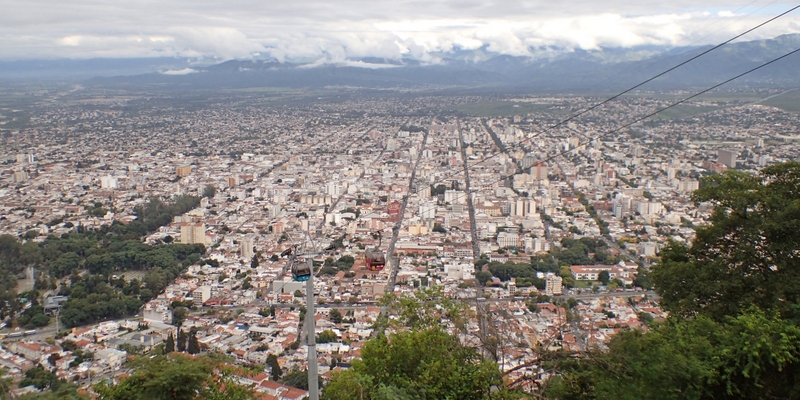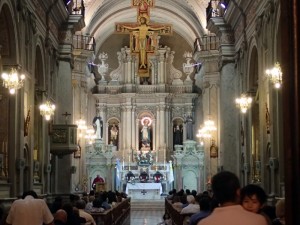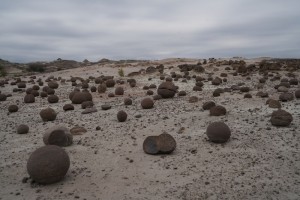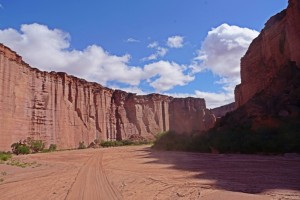Jujuy, Salta & La Rioja: March 24 – 29, 2017
March 24 Friday: Humahuaca – Jujuy – Salta (about 250km)
As I could not find a bus to Salta in the morning, I took a bus first to San Salvador de Jujuy (at an elevation of 1259m), the capital city of Jujuy province with frequent buses to Salta which is about 125km away. My bus left at 7:15 am (ARS 105) and I was in Jujuy before 10am. As the next bus to Salta would not be leaving till 11:30am, I could make a quick tour of Jujuy before taking a bus in the afternoon. The tourist office told me to take a bus to town but the lady did not explain that one had to get a bus card first. As the driver did not allow me to get on, I ended up taking a taxi for ARS 80. A bad start!
Today is Argentina’s National Day of Memory of Truth and Justice and a public holiday. Most places were closed. The driver dropped me off at Plaza Belgrano opposite the Casa de Gobierno and the Iglesia Catedral. The Cathedral was closed. I wandered through all the main streets in this small and dull city. The only place of interest and significance is the Iglesia of St Francisco.
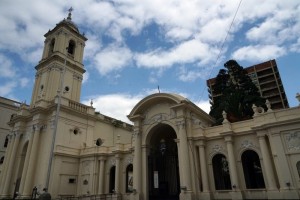 |
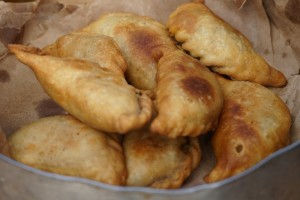 |
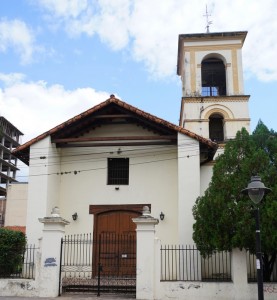 |
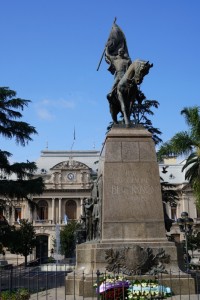 |
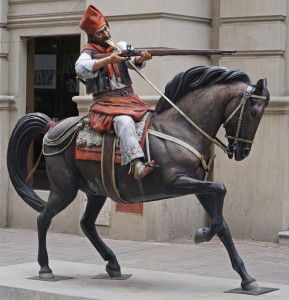 |
As I found nothing better to do, I went in a cafe in a pedestrian street. I ordered a continental breakfast though I already had two delicious empanada in a side street (ARS 5 each). Then I took a taxi back to the bus terminal and paid ARS 85. Jujuy is the most boring place I have visited on the entire trip.
The distance between Jujuy and Salta is about 120km. I took the 2:30pm bus (ARS 165) and arrived in Salta before 5pm. I decided to stay near the bus terminal and found a room at Hotel Continental less than 100m from the terminal for ARS 500. Later I discovered a much nicer one called Petit Hotel with a lovely courtyard and a swimming pool close by.
Salta (1152m above sea level) founded in April 1582 by the Spanish conquistador Hernando de Lerma, is the capital city of Salta province with a population of over half a million. During the War of Independence (1810-1818), it became a commercial and military strategic point between Peru and Argentine cities. Between 1816 and 1821, the city was led by local military leader Martín Miguel de Güemes under the command of General José de San Martín, who defended the city and surrounding area from Spanish forces coming from the further north.
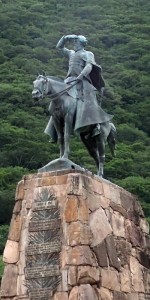 |
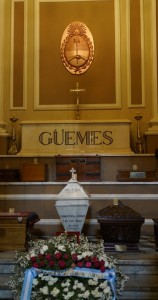 |
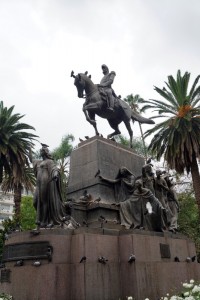 |
The city features a number of buildings dating back to the 18th to early 20th centuries. The picturesque Plaza de 9 de Julio Square (9th of July Square) is surrounded by historical buildings with different architectural styles. The Cabildo (the former city hall) looks Spanish. The Museum of Contemporary Art is in French style. The ornate pink and white Cathedral (1858) and the Museum of High Mountain Archeology (MAAM) are neoclassical. The Church of St Francis nearby is another landmark. There are a few pedestrian streets: Alberdi, Florida and Caseros. San Bernardo Hill that can be reached by car or cable car and on foot, offers a panoramic view of the city and the entire valley.
As soon as I left my luggage, I headed to the city centre and passed by a lovely park with a man-made lake. Unlike Jujuy, Salta was lively with locals and tourists all over the place. I walked in the first travel agent called Salta Connect to enquire about tours. The girls were helpful and I ended up booking two tours for ARS 1100. Later on, I discovered that I could have booked the same tours for as little as ARS900. Lesson to be learnt: Salta is full of tour operators and one should shop around to get the best deal.
The best decision I took today was to visit the MAAM just in time before it closed. The artifacts from the Inca civilisation found in Mt Llullaillaco (6721m) are professionally laid out with some English explanations. The mountain, a sacred one for the Incas with its first recorded climb in 1950, is now the world’s highest archaeological site as mummified remains of three children presumed to have been human sacrifices, were found in the mountain in 1999.
I like the plaza and its atmosphere. Today, the plaza was filled with protestors who I guess are seeking truth and justice. As I did not want to walk back to the hotel too late, I decided to have dinner in a local eatery near the hotel. My dinner was disappointing.
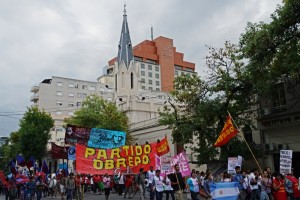 |
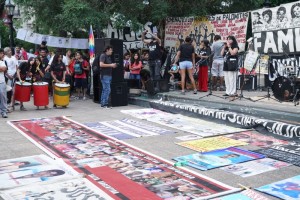 |
I had finished the day with three poor decisions and ‘bad deals’: making a side trip to Jujuy; booking my excursion trips with the wrong agent and picking a wrong place for dinner. Luckily, these are all minor things!
March 25 Saturday: Day Trip Cafayate (400km)
A trip to Cafayate (at an elevation of 1863m) located in the central zone of the Valley of Calchaquies is a must for two reasons. First, the scenery of the 75km-long Quebrada de Cafayate is comparable to Quebrada de Humahuaca. Second, Cafayete is another famous wine-producing area in Argentina. I was told to wait for a pick-up at 7am but the bus was late for half an hour. Then it spent an hour picking up 15 more passengers. It was 8:30am before we left the city. What a waste of time!
We mainly followed Ruta 68 along the Rió las Conchas (Sea Shells River) with half a dozen stops along the way. At the first stop, we saw a small settlement and an abandoned rail station. We spent more time at the Tres Cruces (three crosses) which affords great views of the river and the valley.
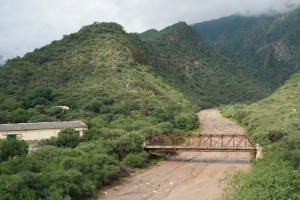 |
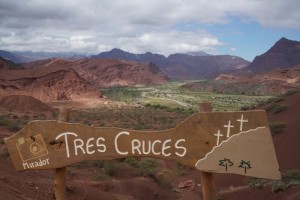 |
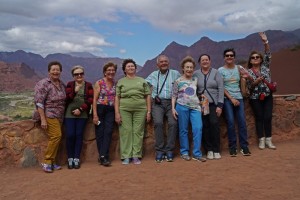 |
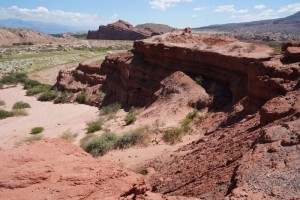 |
We had a brief stop to look at coloured mountains. Along the way, our guide pointed out many natural sculptures by wind including el Sapo (frog), el Fraile (old monk) and el Obeliso (obelisk).
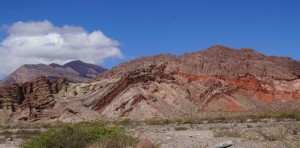 |
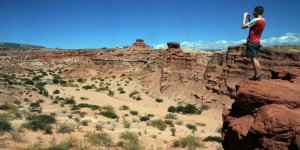 |
We arrived in Cafayate for lunch. The town is small with over 10,000 inhabitants and a few streets. There are a plaza and a church in the middle of the town. Instead of eating in a tourist restaurant next to the plaza, I found a simple eatery and had cazuela (soup with beans), a baked empanada and wine for less than ARS 150. Delicious and wholesome local food!
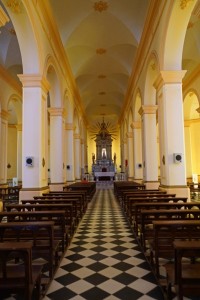 |
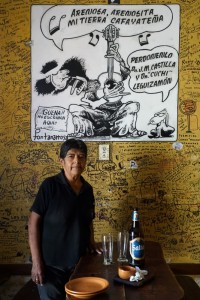 |
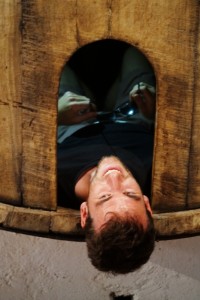 |
Of course, we could not leave without visiting a vineyard. We had a quick tour of a small winery at the entrance of the town. The guide told us to climb inside one of the large barrels through a very small opening. Six of us who are not obese managed to get in without problem: we could stand up and move around comfortably. This gives an idea how large the barrel is!
On the way back, the driver took us to the natural amphitheatre with excellent acoustic. The final stop was the Devil’s Throat. I was back in my hotel after 8pm and went to bed early.
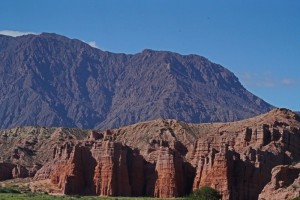 |
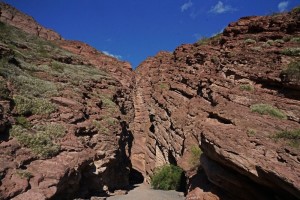 |
March 26 Sunday: Day Trip to Cachi (320km)
Today I travelled with a larger group in a bus with a guide and driver to the northern end of the Calchaquies Valley which is greener with different landscape and scenery. There are several highlights. First, the 21km-long Bishop’s Road which winds through the mountain range, is impressive. Unfortunately, I was so tired that I dropped off several times. We had a couple of photo stops along the route. Anyway, the spots are not as photogenic as those in the Quebrada de Cafayate.
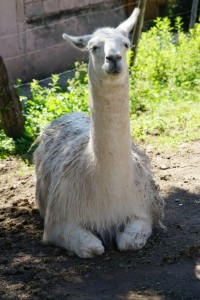 |
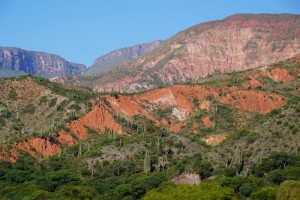 |
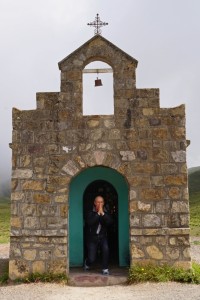 |
Second, we arrived in Cachi (2280m) at noon. Located in the northern section of the Calchaqui Valley with the snow-clad Nevado de Cachi (6380m) as backdrop, Cachi with its white-washed buildings and a leafy plaza, is idyllic and picturesque.
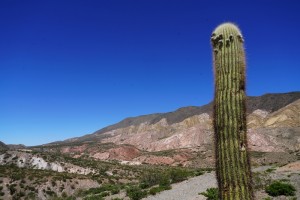 |
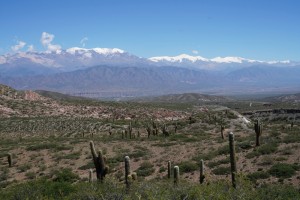 |
We had two hours for lunch and sightseeing. I visited the Iglesia San Joséand the Archaeological Museum housed in a beautiful colonial building next to the church. Though the information is in Spanish, I can guess the significance of some of the artifacts on display. The guide took us to a restaurant close to the plaza. I did not like the tourist menu. Instead I went to a restaurant built with abode and a straw roof. I had beef and wine. The chef gave me a small piece of cabrito (roast suckling goat) to taste: the meat was juicy, tender, tasty and most delicious!
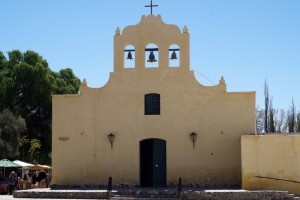 |
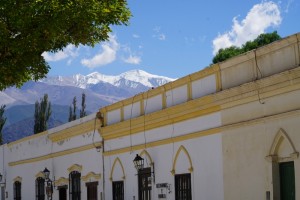 |
Our last stop was the Los Cartones (cactus) National Park. There are some illustrations about the nature of cactus and how it grows. But the cactus growing near the road looks less impressive as compared with those far away from the road and on the slope.
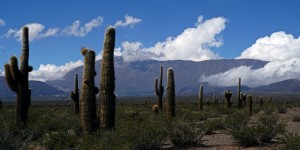 |
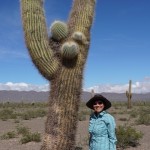 |
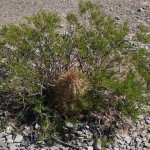 |
I was dropped off in my hotel after 7pm. As it’s my last night in Salta, I decided to see the city centre by night. It is a 25-minute walk to the centre. I went to both the Cathedral and the Church of St Francis both of which were beautifully illuminated. Both were fully of church-goers attending the 8pm mass.
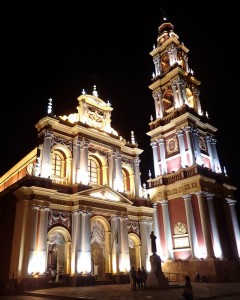 |
The plaza is atmospheric in the evening with the buildings illuminated. I had an ice cream and sat in the plaza for ten minutes. It was nice, cool and atmospheric.
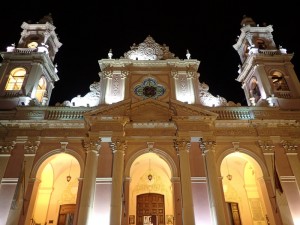 |
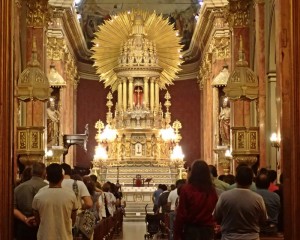 |
March 27 Monday: Salta – La Rioja
I had a whole day in Salta as the bus to La Rioja would not be leaving till 8:30pm. All museums are closed on Monday. Hence the only thing on my agenda was a visit to San Bernando Hill (1454m). I spent over two hours walking from my hotel to the hill top. It’s a pleasant walk: the trail with 1007 steps is not difficult. As the weather was fine with a clear sky, I had fabulous panoramic view of the city and the expansive plain below.
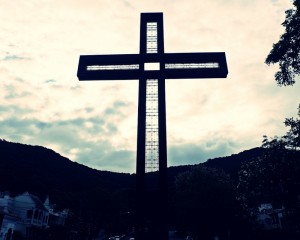 |
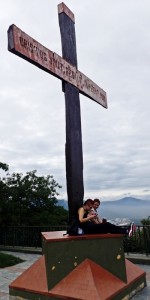 |
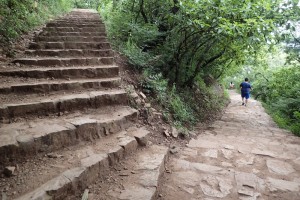 |
I checked out shortly after 11am before spending the next few hours wandering around the city centre. I saw a group of pilgrims in the cathedral and was tempted to visit the museum and convent of the Church of St Francis. But I decided to give it a miss as I would not understand the information in Spanish.
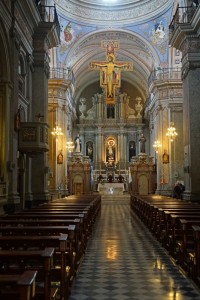 |
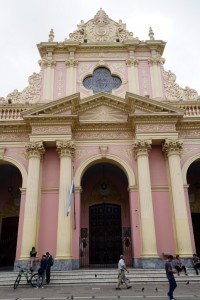 |
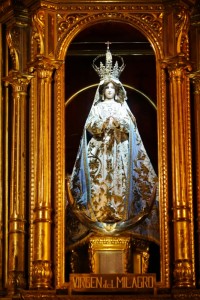 |
I changed money at the BMV Bank which offered the best rate I had so far i.e. $1 to ARS 15.8. I had a sumptuous lunch with steak and wine in a good restaurant for ARS 260. Fantastic value! I was back in the hotel shortly after 3pm and spent the rest of the afternoon writing travel notes.
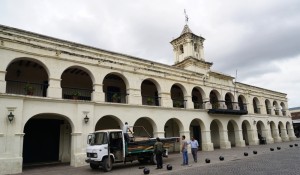 |
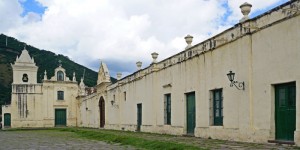 |
Around 6pm it started to rain heavily with lighting and thunder. Luckily around 8pm, the torrential rain almost stopped. I got my feet wet when crossing the road to the bus terminal. I paid only ARS 960 for an overnight ride to La Rioja (about 700km). The bus left the terminal at 8:30pm but stopped after 45 minutes by a petrol station. I did not know what was happening. Luckily an English-speaking Argentine couple told me that we had to move to another bus coming from the north probably Bolivia. The incoming bus was late and we were on the road again around 11pm. The bus was not full and I had plenty of room. But I still could not sleep well.
March 28 Tuesday: La Rioja
La Rioja founded in 1591 located at the foot of Velasco Sierras and 1167km from Buenos Aires, is the capital city of La Rioja province with a population of 150,000 (2001 census). The province boasts two World Heritage Cultural Sites namely Ishiganlato / Talampaya National Park and Qhapaq Ñan Andean Road System.
By 9am, I arrived at the terminal and had to take a taxi to the Libertador Hotel which is three blocks from the city plaza. I got a room for ARS 600 a night. As this city is off the beaten route, it is not easy to find organised tour to the national park in off-season. The tourist information office gave me the name of an operator in the mall nearby. I approached the operator but no one had signed up for a tour for the following day. I put my name down and hoped he could find a couple more passengers. Otherwise, I was prepared to pay for a car to take me to the park. He told me to return to check in the afternoon.
My next stop was the National Bank of Argentina where I got ARS 170 for an euro. The bank is most inefficient. I can see some of the problems besetting Argentina’s national bank including archaic procedures, poor and inefficient management, inadequate provision of modern equipment and IT service.
I came to La Rioja primarily to visit the national park. As I was not sure whether the tour operator would get a group, I went to Wayra Hostel which is popular with backpackers and hoped to find a tour. But the receptionist was very pleasant and helpful: she made enquiries and told me to return in the afternoon to check. The same answer!
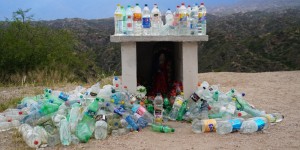 While waiting, I discovered a 3-hour trip which cost ARS 490. As I found the city dull, I decided to take this trip and explore the surrounding areas. She told me to return at 3pm. I seemed to spend the whole day walking from one end of the city to the other end. On my second trip to the hostel, I stopped by the tour operator in the mall who had found two more passengers. This meant that each of us would pay ARS 1450 to the driver and our own entrance fees. I was thrilled.
While waiting, I discovered a 3-hour trip which cost ARS 490. As I found the city dull, I decided to take this trip and explore the surrounding areas. She told me to return at 3pm. I seemed to spend the whole day walking from one end of the city to the other end. On my second trip to the hostel, I stopped by the tour operator in the mall who had found two more passengers. This meant that each of us would pay ARS 1450 to the driver and our own entrance fees. I was thrilled.
I was back in the hostel after having a nice lunch. Alexis, owner of the hostel, was waiting for me. He drove me to Los Sauces, a man-made lake, a village Sangasta before following a scenic route Pampa de la Viuda. We stopped at a viewpoint which affords panoramic of the expansive basin. I saw a shrine on the road side with plastic bottles piling up around it. Alexis explained the tradition of leaving bottles for La Difunta Correa, a local deity.
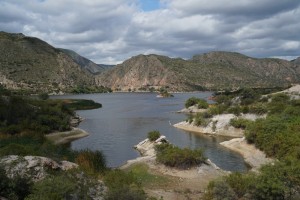 |
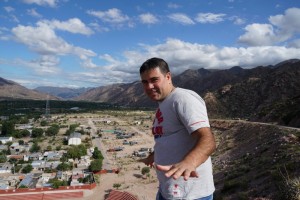 |
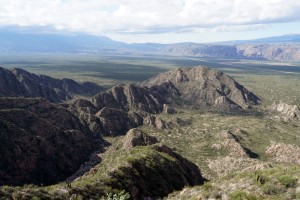 |
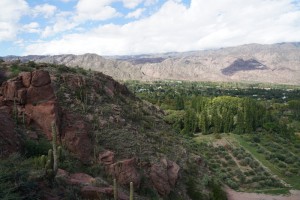 |
The landscape and scenery are not as stunning as those I have seen so far. Nonetheless, I enjoy talking with Alexis who is 32 and whose passion is flying. He is pleasant, positive and energetic: he is planning to open a hostel catering for people coming to La Rioja to fly.
March 29 Wednesday: Ishiganlato / Talampaya National Park (565km)
Ishiganlato / Talampaya National Park
Ischigualasto Provincial Park (60,369 hectares) in San Juan Province and Talampaya National Park (215,000 hectares), jointly cover 275,369 hectares west of the Sierras Pampeanas. Situated within Argentina’s Monte ecoregion, a warm scrub desert along the Eastern Andean foothills, this World Heritage property is a scientific treasure of global importance. It harbours the sedimentary Ischigualasto-Villa Union Triassic Basin, consisting of continental sediments deposited during the entire Triassic Period and boasting an exceptionally complete record and sequence of plant and animal life in the geological period from roughly 250 to 200 million years ago which represents the origin of both dinosaurs and mammals. Six distinct sedimentary formations contain the fossilised remains of a wide range of ancestral animals and plants revealing the evolution of vertebrates and detailed information on palaeoenvironments over the approximately 50 million years of the Triassic Period, and the dawn of the “Age of the Dinosaurs”. The ongoing scientific discoveries are invaluable for understanding palaeontology and evolutionary biology.
The property also has important archaeological values, such as 1500 year-old petroglyphs. Exceptional landscape features include red sandstone cliffs reaching 200 metres in height in Talampaya National Park and, in Ischigualasto Provincial Park, white and multi-coloured sediments creating a stark landscape named “Valle de la Luna” (Valley of the Moon). The site has sparse desert vegetation, characterised by xeric shrubs and cactus, with interspersed trees. The desert environment contains several rare and endemic species of flora and fauna. (The information above is extracted from www.whc.unesco.org)
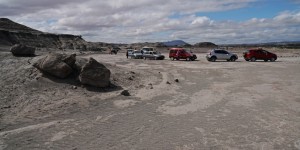 I had a long day. First I checked out and left my luggage at the reception at 6:30am. The driver, Juan arrived at 7am and we went to pick up a young couple from Buenos Aires. He drove for two hours along RN 38 and 150 before we reached the Ishiganlato National Park. The entrance fee is ARS 250. Visitors have to come with their own vehicles and follow a ranger to take a 40 km – long tour in the park. This morning, there were seven cars and two motor-bike with 17 visitors.
I had a long day. First I checked out and left my luggage at the reception at 6:30am. The driver, Juan arrived at 7am and we went to pick up a young couple from Buenos Aires. He drove for two hours along RN 38 and 150 before we reached the Ishiganlato National Park. The entrance fee is ARS 250. Visitors have to come with their own vehicles and follow a ranger to take a 40 km – long tour in the park. This morning, there were seven cars and two motor-bike with 17 visitors.
The eerie and expansive landscape is extraordinary and stunning. I have been many places which are called “Valley of the Moon”. I must say this is the grandest and most interesting I have visited so far. We had an excellent 3-hour guided tour with five stops. At the first stop at the edge of a cliff, we looked below the landscape with sands and mud of all sorts of colours and shapes.
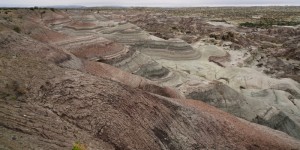 |
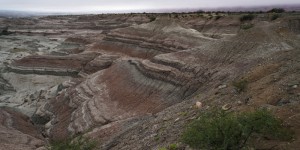 |
At the second stop, we had a guided walk (about a kilometre) which allows us to get close to impressive rock formations. We also saw some polish round stones which can be found only at this location. We saw a variety of flora.
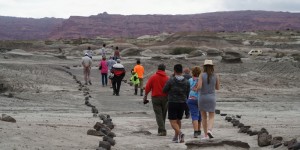 |
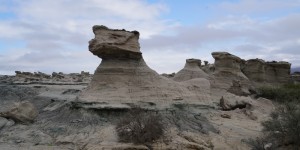 |
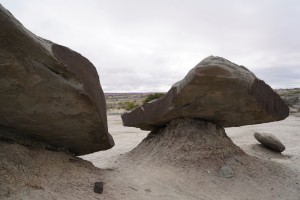 |
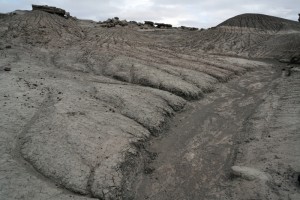 |
At the third stop “El Sumbmarino”, we took pictures of an iconic rock formation which often appears in postcards. There were once two similar rocks: one has now gone during weathering.
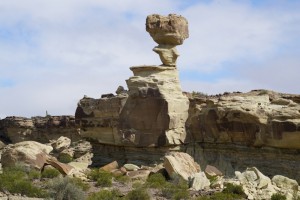 |
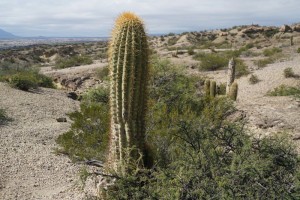 |
The next stop took us to the museum built over the site where three dinosaurs fossils had been found. The staff gave a detailed explanation on site in Spanish which I could not understand. Upon my inquiry, she told me some 30 species of dinosaurs have been found in the park with over 3000 pieces of fossils.
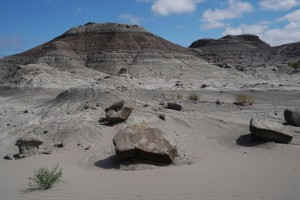 |
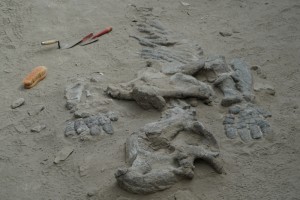 |
The last stop was at “El Hongo” to look at a rock formation in the shape of mushroom.
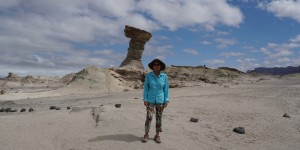 |
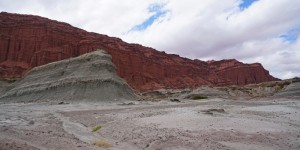 |
Three hours went quickly and the landscape in this remote corner of the world is outstanding and unearthly. Juan then drove some 75km to reach the Talampaya National Park.
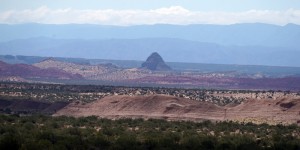 |
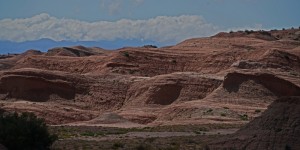 |
Here I paid an entrance fee of ARS 250 and a guided safari tour (ARS 600) in 4×4 with four stops in the canyon. The guided tour started at 2:30pm with 15 passengers. We entered the Talampaya canyon which extends about 4 km with walls of 150m high.
At the first stop we followed a 350m-long boardwalk to see different motifs / petroglyphs of animals and men who had passed through the region till the arrival of the Spaniards.
 |
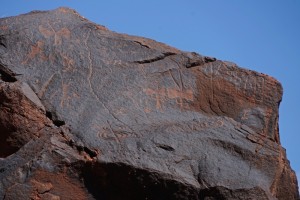 |
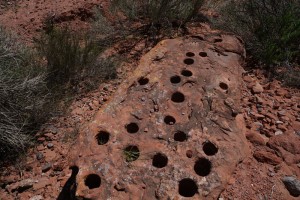 |
Then we had a pleasant walk in the botanic garden which is lushly green. It is unbelievable to see woody tall trees in a desert! Even more amazing is the echo effect at a particular section of the cliff wall. Another big surprise awaited us: the driver had set up a table with wine and snacks on the other side of the vehicle without our notice. I had two glasses of white wine in the middle of a canyon!
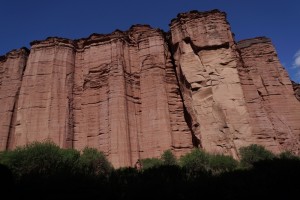 |
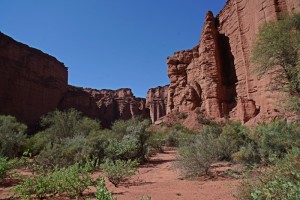 |
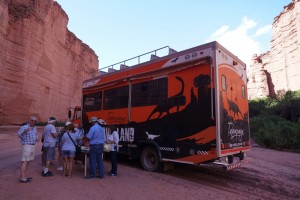 |
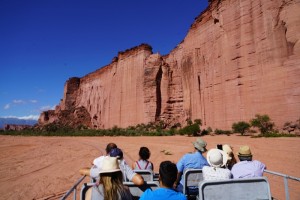 |
The third stop was at the “Gothic Cathedral”. The shape of the rocks on the foot of the canyon cliff resembles a Gothic cathedral.
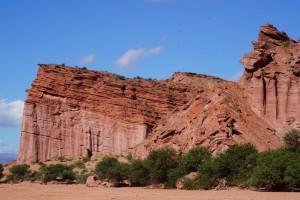 |
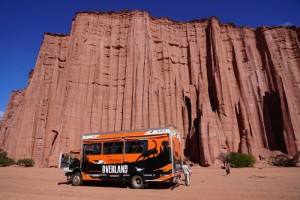 |
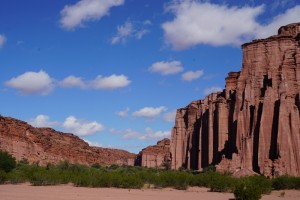 |
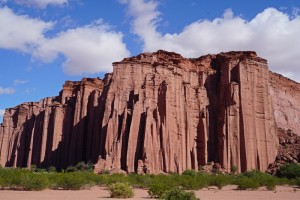 |
The last stop was at “El Monje” where there are a couple of tall free-standing rock formations in the shape of a monk, a tower and a bottle.
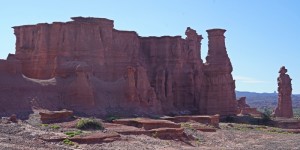 |
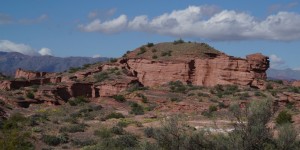 |
Before leaving, I had a quick self-guided walk following the “Trail of the Triassic” where replicas of a dozen species of dinosaurs are shown in real size based on the remains fossils found in this park.
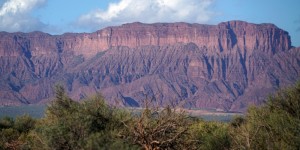 |
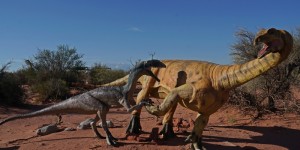 |
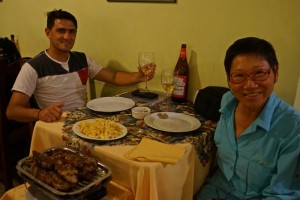 It was after 8pm when I got back to town. As my bus would leave after 11pm, I invited Juan to join me for dinner at Casona Grilled, a popular restaurant. I paid ARS 650 for two grilled ribs, a large beer and two salad. Juan is a nice young man who teaches geography at the university. He kindly offered to take me to the bus terminal. My bus to Mendoza departed on time at 11:15pm. I paid only ARS 875 (on promotion) for the ride. The bus was comfortable and had only a dozen of passengers. I had plenty of room but could not sleep as usual.
It was after 8pm when I got back to town. As my bus would leave after 11pm, I invited Juan to join me for dinner at Casona Grilled, a popular restaurant. I paid ARS 650 for two grilled ribs, a large beer and two salad. Juan is a nice young man who teaches geography at the university. He kindly offered to take me to the bus terminal. My bus to Mendoza departed on time at 11:15pm. I paid only ARS 875 (on promotion) for the ride. The bus was comfortable and had only a dozen of passengers. I had plenty of room but could not sleep as usual.



